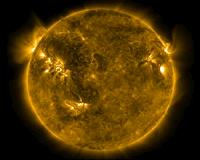 |
for Launchspace Bethesda MD (SPX) Feb 01, 2011 Our Sun has been around for about 4.6 billion years, and will probably last for another few billion years. Although this may seem to be a long time, it is a relatively short interval in the life of the Universe. In time what will happen to the Sun and to the human race? The Sun is a main sequence star, i. e., it burns hydrogen at its core and creates helium through a fusion process. In fact, 600 million tons of protons are converted into helium atoms every second, giving off a tremendous amount of energy. Over its life the Sun is slowly using up more and more of its hydrogen, causing it to become more luminous. In about a billion years the Sun will be 10% brighter than it is today. This means more energy will be reaching the Earth, causing a moist greenhouse effect. The result will be a drying out of our atmosphere and the loss of water vapor to space. In about 3.5 billion years, our Sun will be 40% brighter than it is today, causing the oceans to boil and the resulting water vapor to be lost to space. The ice caps will melt. Snow will be ancient history. Life will be unable to survive and Earth will resemble dry hot Venus. In about 6 billion years, the Sun will run out of hydrogen. At this point inert helium ash built up in the core will become unstable and collapse under its own gravitational attraction. This gravitational collapse will cause the core to heat up and get denser. The Sun will then grow in size and enter the "red giant" phase of star evolution, consuming the orbits of Mercury and Venus, and probably Earth. At this point in its evolution the Sun will burn helium in its core, creating carbon and oxygen for about 100 million years, until this source of fuel is exhausted. Finally, the shell of helium will become unstable causing the Sun to pulse violently and a large portion of its atmosphere will blow off over the course of several pulses. Without an atmosphere our old Sun will be simply the carbon-oxygen core created when it was burning helium. It will then be a "white dwarf" the size of the Earth. Without fusion it will slowly cool down, eventually becoming the same temperature as the background of the Universe. The Sun's ultimate future will be cold and bleak. Although there is no reason to be concerned in the near term, there is good reason to start thinking about how to find and colonize another home for the human race. Fortunately, NASA and other research organizations are working on the issue of finding other planets that may one day host humans. In fact, the recently launched Kepler Space Telescope and existing ground-based telescopes have been searching for "exoplanets," i. e., extrasolar planets that are outside of our Solar System. Just last week astronomers announced the confirmed detection of 519 exoplanets and hundreds more planet candidates awaiting confirmation after more detailed investigations. Although all exoplanets are not necessarily suitable for human life, there is a statistical probability that some small, but finite, number of them have the required properties to support human colonies. However, assuming we can find at least one of this agreeable exoplanets, getting there will not be easy. It is almost a certainty, thanks to the size of our Milky Way galaxy, that our new home will be at least thousands of light years away. Assuming Einstein was right and we will not be able to travel at warp speed, the time to travel to that new home will be at least tens of thousands of years. It seems that we will need a futuristic version of Noah's Ark, fully high tech and completely self contained. In other words, a complete and true ecosystem, capable of perpetuating thousands of generations of a human colony while travelling to a new home. If the human race can survive itself during the few million years, it can look forward to a long, long journey to a new Earth.
Share This Article With Planet Earth
Related Links Launchspace Solar Science News at SpaceDaily
 What Impact Would Sun Dimming Have on Earth's Weather
What Impact Would Sun Dimming Have on Earth's WeatherLondon UK (SPX) Jan 27, 2011 Solar radiation management projects, also known as sun dimming, seek to reduce the amount of sunlight hitting the Earth to counteract the effects of climate change. Global dimming can occur as a side-effect of fossil fuels or as a result of volcanic eruptions, but the consequences of deliberate sun dimming as a geoengineering tool are unknown. A new study by Dr Peter Braesicke, from the Ce ... read more |
|
| The content herein, unless otherwise known to be public domain, are Copyright 1995-2010 - SpaceDaily. AFP and UPI Wire Stories are copyright Agence France-Presse and United Press International. ESA Portal Reports are copyright European Space Agency. All NASA sourced material is public domain. Additional copyrights may apply in whole or part to other bona fide parties. Advertising does not imply endorsement,agreement or approval of any opinions, statements or information provided by SpaceDaily on any Web page published or hosted by SpaceDaily. Privacy Statement |